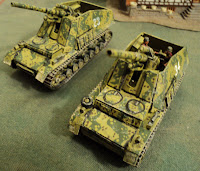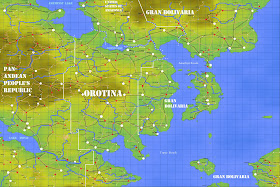At last: finished. Well, sort of finished. The Hummels have been built, painted and one of them at least has a crew - two figures from the Airfix SdKfz234/4 Armoured Car kit. This first picture was taken before 'weathering', the others after. This might not be apparent in most pictures. I have a fairly minimalist approach to weathering, though these vehicles could stand more, methinks.
Close up of the fighting compartment, with crew added. This won't win any prizes - the number could be touched up, and certain other little flaws reveal themselves. This ain't Verlinden quality modelling by any stretch. But on the whole I'm not at all unhappy with the end result.
I have found the best method of getting track to look right is glue and staple the ends together. To the objection that the staple will spoil the appearance of the vehicle, the answer is [A] make sure the stapled but is up under the superstructure overhang, and [B] paint it out with some dark colour - black, even.
As mentioned earlier, the gun came without some of the extra bits like hydraulic elevating gear, and traversing and fine adjusting wheels and handles. Figuring that as they would in general be hidden in the superstructure, I was not at first going to bother with them. I am glad I changed my mind about that. On the other hand, unlike the original ESCI kit, which moulded them in, I left off the seats either side of the gun and the boxes on the floor near the rear. Another good decision, I feel.
Vehicles 23 and 34 in battery. Well, they won't be part of the same unit for long. Brian (A Fist Full of Plastic) will get one of them; the other will remain in my own army forming a Command Decision SP battalion with 2, maybe 3, 10.5cm Wespes.
 |
| Have gun; will hunt. |
Whilst working on the Hummels, I also began some repair and refurbish work on some other vehicles Brian had given me or that I had had waiting (clamouring) for my attention for some considerable time.
This Hunting Tiger just needed the tracks put on, the mudguards re-attached and the gun refitted. In painting this vehicle I discovered that 'German Cavalry Brown' is very reddish in colour. I know, I know - I ought to have used 'Chocolate' but my feeling is that it is rather a brownish sort of brown, and I did want reddish in the camo.
Rear view of JagdTiger going off to hunt something. I rather like this simplistic ESCI kit.
Also in my possession were a couple of Tigers that badly needed a refurbish. The one Brian gave me looked OK, but the paint scheme didn't 'fit' with my preferred livery. So they both got a repaint. Probably they would have benefited at that from having their original paint job stripped off, but I wasn't prepared to put up with the hassle.
I painted over the top. It shows a bit - these vehicles are a tad rough, but, seen at the usual distance one views these things on the war games table, they look rather better than these pictures indicate.
My real bugbear are the tracks. For one thing, they were put on differently for each vehicle, they were flimsy, flopped about all over the place, and the ends were untidily put together. The bad part, I discovered, was that they were apparently glued up under the overhang. At any rate, They could not be removed safely.
Faute de mieux I left them as they were, except that I glued the road wheels down onto the tracks as well. This was not a total success (as the right-hand track on Tiger 511 shows.
But the key thing is, they are Tigers. I now have the beginnings of a Tiger Company (Heavy Panzer Company 651 in the service of Orotina) which will comprise 3 Tigers (the third being a metal model from Dragon, painted Panzergrau), plus a Panzer IIIN with the short barrelled 7.5cm gun.
Further to the camo: I don't really know if the scheme I have here was ever used by the Germans. But, for mine, it looks as though it might have been. What commends itself to me is that I doubt anyone will be using it, which identifies my stuff as being mine! And, of course, it looks OK - well it does to me!


















